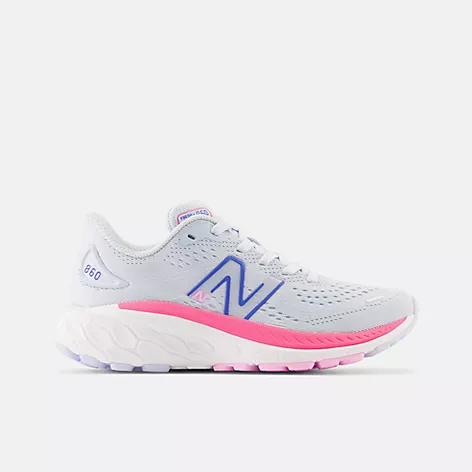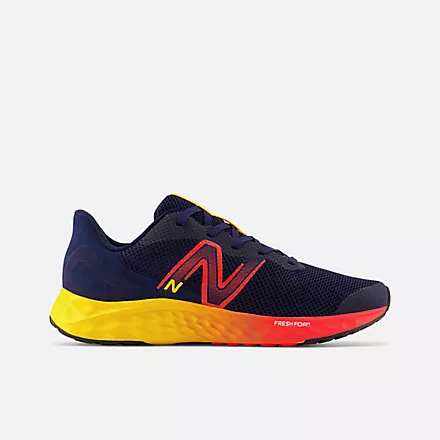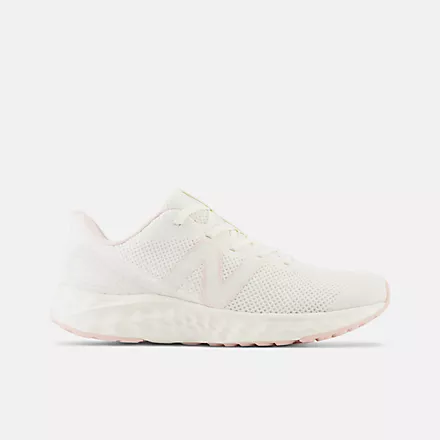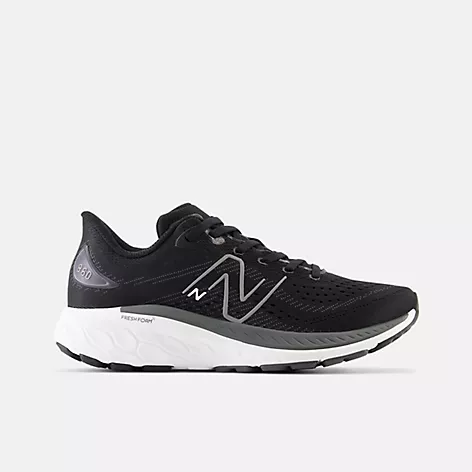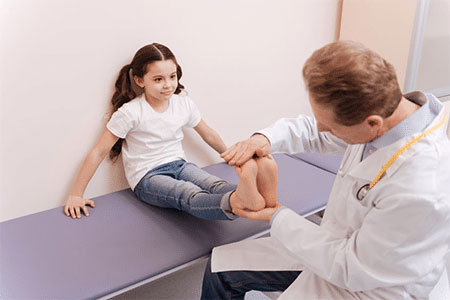Best Kids’ Shoes for Sesamoiditis – Extra Cushion and Support for Your Child’s Feet!
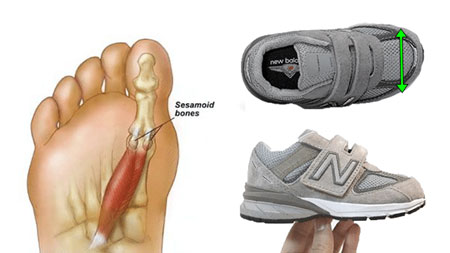
Is your child complaining about pain on the bottom of the foot and having difficulty bending and straightening the big toe? Has your child been diagnosed with sesamoiditis? This condition is a type of tendonitis that can affect the ball of the foot, specifically underneath the big toe.
The good news is that certain shoes provide extra cushion and support that can help treat this condition and reduce the pressure on the ball of the foot. I have put together a list of the best kids’ shoes for sesamoiditis based on my 10 years of shoe fitting experience.
Sesamoiditis develops when your child’s small bones located under the big toe are irritated or injured due to overuse and repetitive impact. Did you know that children who are involved in high-impact activities and sports are more prone to developing this condition? The repetitive stress on their feet can lead to an inflammation of the bone.
Fitting children in unsupportive shoes can also lead children to put extra pressure on the ball of the foot and damage those sensitive tendons around the sesamoid bones. If you’re pressed for time, you can jump directly to the selection of the best kids’ sneakers for sesamoiditis.
Can Shoes Help Treat and Prevent Sesamoiditis?
Yes, certain shoes provide extra padding and support that can help alleviate pressure away from the seasoned bones. It’s also important that the shoes have round and wide toe boxes so your child’s toes don’t overlap against one another, as this can only aggravate the condition.
Many medical professionals refer children to the shoe store that I work for to be fitted for the correct pair of shoes and orthotics. Over the years I have noticed that girls who participate in sports such as dance and running were more prone to developing this condition, and I have arrived at the same conclusion for boys who play soccer, basketball, and football.
Most children who were fitted in supportive shoes noticed an immediate improvement in symptoms.
What Makes the Shoes that I Recommend Ideal for Sesamoiditis?
The shoes that I recommend provide 3 key features that makes them ideal for sesamoiditis:
1️⃣ Substantial Outsole: Shoes with supportive outsoles and shock-absorbing capabilities that have extra padding and cushion can help alleviate pressure away from the seasoned bones. Let me show you the difference in cushioning and support between one of the shoes that I recommend and a different style. I will provide you with a link to this specific shoe style shortly.
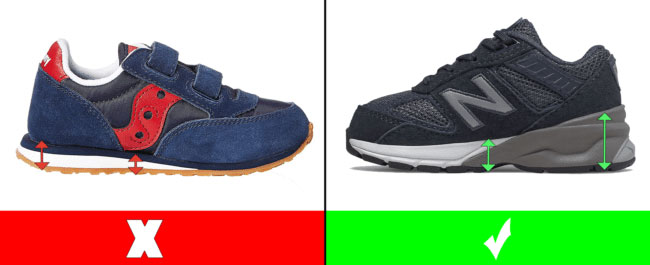
2️⃣ Rounder Toe-Box: This feature prevents your child’s toes from overlapping each other or rubbing against the side of the shoes. Shoes with round toe-boxes allow your child’s big toe to straighten out and the sesamoids can rotate back into a more natural position. Let me show you the difference between a shoe with a round toe-box versus one with a narrow toe-box. I will also provide you with a link to the shoe below.
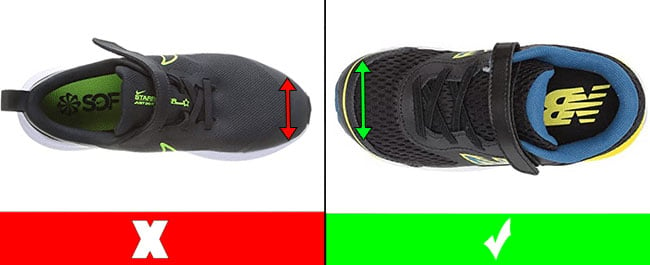
3️⃣ Extra Depth: This feature allows the child’s feet to fit deeply inside the shoes and prevents the top part of your child’s toes from rubbing against the top part of the shoes. Shoes that provide extra depth are also ideal to accommodate orthotics. Let me show you the difference in depth between two shoes that are the same length and width:
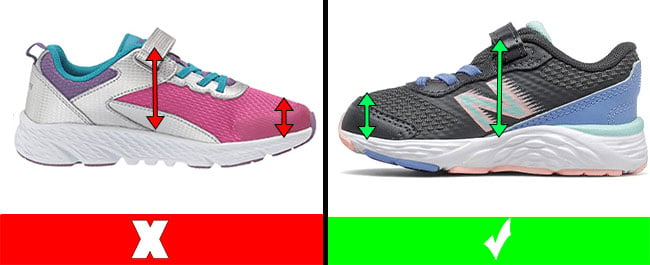
The Importance of Providing Children with the Correct Shoe Size
Shoes that are too short or too narrow can aggravate this condition. I suggest that you take your child to be properly fitted for shoes at your local specialized shoe store. The issue is that most specialized children’s shoe stores have been closing down (even before the COVID-19 pandemic), and most families don’t know where to take their children to be properly fitted for shoes. The good news is that there is a different resource I created that will help you retrieve your child’s shoe size in two simple steps.
Let’s now take a look at a selection of the best kids’ shoes for sesamoiditis. Disclosure: Some links in this post may be affiliate links and we may receive a small commission (at no extra cost to you) when you click our links and make purchases.
Best Kids’ Shoes for Sesamoiditis
All of the shoes below are available in different widths such as medium (M), wide (W), and extra wide (XW) widths. This is important to note as you must make sure that your child’s shoes are wide enough to prevent the toes from overlapping one another or rubbing against the side of the shoes.
Little Kid Shoe Sizes (10.5 to 3)
- Shoe style Fresh Foam X 860v13
- Available in medium and wide widths
- Lace-up closure
- Fresh Foam midsole cushioning is precision engineered to deliver an ultra-cushioned, lightweight ride
- Ultra Heel design hugs the back of the foot for a snug, supportive fit
- Order this shoe half a size larger than your child’s current foot size
- Shoe style RaveRun by New Balance
- Available in medium, wide, and extra wide widths
- Lace-up closure
- Fresh Foam midsole cushioning is precision engineered to deliver an ultra-cushioned, lightweight ride
- Ultra Heel design hugs the back of the foot for a snug, supportive fit
- Order this shoe half a size larger than your child’s current foot size
- Shoe style Axon by Saucony
- Available in medium and wide widths
- EVA midsole provides increased shock attenuation, responsive cushioning and lasting durability
- Cushioned footbed
- Order this shoe a whole size larger than your child’s current foot size
- Shoe style Axon by Saucony
- Available in medium and wide widths
- EVA midsole provides increased shock attenuation, responsive cushioning and lasting durability
- Padded tongue and collar
- Cushioned footbed
- Order this shoe a whole size larger than your child’s current foot size
- Shoe style Fresh Foam X 860 V13 by New Balance
- Available in medium and wide widths
- Lace-up closure
- Dual-layer midsole construction featuring top-bed foam cushioning and underfoot Fresh Foam X
- Order this shoe half a size larger than your child’s current foot size
- Shoe style Fresh Foam X 860 V13 by New Balance
- Available in medium and wide widths
- Lace-up closure
- Fresh Foam midsole cushioning is precision engineered to deliver an ultra-cushioned, lightweight ride
- Order this shoe half a size larger than your child’s current foot size
- Shoe style RaveRun by New Balance
- Available in medium, wide, and extra wide widths (fits high insteps)
- Lace-up closure
- Dual-layer midsole construction featuring top-bed foam cushioning and underfoot Fresh Foam X
- Order this shoe half a size larger than your child’s current foot size
- Shoe style Fresh Foam X 860v13 by New Balance
- Available in medium and wide widths
- Lace-up closure
- Strong rubber outsole and cushioned midsoles
- Order this shoe half a size larger than your child’s current foot size
- Shoe style TR14 LTT by Saucony
- Available in medium and wide widths
- Lace-up closure
- Foam padding placed around your ankle collar and under the tongue for an incredibly comfortable fit and feel
- Comfort sockliner molds to your foot with padding in the heel for ultimate cushioning at heel-strike
- Engineered mesh for structure, stretch and enhanced breathability
- Order this shoe half a size larger than your child’s current foot size
- Shoe style Cohesion TR14 LTT by Saucony
- Available in medium and wide widths
- Lace-up closure
- Foam padding placed around your ankle collar and under the tongue for an incredibly comfortable fit and feel
- Comfort sockliner molds to your foot with padding in the heel for ultimate cushioning at heel-strike
- Engineered mesh for structure, stretch and enhanced breathability
- Order this shoe half a size larger than your child’s current foot size
Big Kid Shoe Sizes (3.5 to 7)
- Shoe style Fresh Foam Arishi by New Balance
- Available in medium and wide widths
- Lace-up closure
- Fresh Foam midsole cushioning is precision engineered to deliver an ultra-cushioned, lightweight ride
- Ultra Heel design hugs the back of the foot for a snug, supportive fit
- Order this shoe half a size larger than your child’s current foot size
- Shoe style Fresh Foam Arishi v4 by New Balance
- Available in medium, wide, and extra wide widths
- Lace-up closure
- Fresh Foam midsole cushioning is precision engineered to deliver an ultra-cushioned, lightweight ride
- Ultra Heel design hugs the back of the foot for a snug, supportive fit
- Order this shoe half a size larger than your child’s current foot size
- Shoe style Kinvara by Saucony
- Available in medium and wide widths
- EVA midsole provides increased shock attenuation, responsive cushioning and lasting durability
- Padded tongue and collar
- Cushioned footbed
- Order this shoe a whole size larger than your child’s current foot size
- Shoe style Kinvara by Saucony
- Available in medium and wide widths
- Foam padding placed around your ankle collar and under the tongue for an incredibly comfortable fit and feel
- Comfort sockliner molds to your foot with padding in the heel for ultimate cushioning at heel-strike
- Engineered mesh for structure, stretch and enhanced breathability
- Order this shoe half a size larger than your child’s foot size
- Shoe style RaveRun by New Balance
- Available in medium, wide, and extra wide widths (fits high insteps)
- Lace-up closure
- Dual-layer midsole construction featuring top-bed foam cushioning and underfoot Fresh Foam X
- Order this shoe half a size larger than your child’s current foot size
- Shoe style RaveRun by New Balance
- Available in medium, wide, and extra wide widths
- Lace-up closure
- Fresh Foam midsole cushioning is precision engineered to deliver an ultra-cushioned, lightweight ride
- Ultra Heel design hugs the back of the foot for a snug, supportive fit
- Order this shoe half a size larger than your child’s current foot size
- Shoe style Fresh Foam X 880v12 by New Balance
- Available in medium and wide widths (fits high insteps)
- Lightweight EVA foam cushioning in the midsole and padded heel increases comfort
- Firm heel counter
- Supportive heel for active kids
- Breathable mesh upper
- Order this shoe a whole size larger than your child’s current foot size
- Shoe style FuelCell Propel v5 by New Balance
- Available in medium and wide widths (fits high insteps)
- Lace-up closure
- Dual-layer midsole construction featuring top-bed foam cushioning and underfoot Fresh Foam X
- Order this shoe a whole size larger than your child’s current foot size
- Shoe style Kinvara 14 by Saucony
- Available in medium and wide widths
- Lace-up closure
- Lightweight mesh upper
- Fresh Foam midsole cushioning is precision engineered to deliver an ultra-cushioned, lightweight ride
- Order this shoe half a size larger than your child’s current foot size
- Shoe style Arishi Fresh Foam by New Balance
- Available in medium, wide, and extra wide widths (fits high insteps)
- Fresh Foam midsole cushioning is precision engineered to deliver an ultra-cushioned, lightweight ride
- Lightweight mesh upper
- Order this shoe a whole size larger than your child’s current foot size
- Shoe style Axon by Saucony
- Available in medium and wide widths
- EVA midsole provides increased shock attenuation, responsive cushioning and lasting durability
- Cushioned footbed
- Order this shoe a whole size larger than your child’s current foot size
Are You Unsure About Which Shoe Will Work Best for Your Child’s Feet?
If you don’t know which specific shoe might work best for your child’s specific foot shape don’t hesitate to send me an email:
Are Children with High Arches More Prone to Developing Sesamoiditis?
Children with high arches or children who walk on their toes have an increased risk of experiencing sesamoiditis because of the extra pressure that they put on their feet.
It’s important for parents to be proactive to prevent progression to chronic pain or the need for surgical intervention.
The Importance of Being Proactive and Taking Early Action!
If you leave your child’s sesamoiditis untreated for a prolonged period, permanent damage can be caused to the sesamoid bones in the feet.
Did you know that being proactive and taking early action can lead to a quicker and more successful treatment? I was told by a podiatrist that it’s important to be proactive with children and their treatment since the first 7 years of life are their “golden years of treatment opportunity”. During these years permanent structural changes of the foot and lower extremity may be relatively easily obtained with treatments such as orthotics, supportive shoes, and therapeutic exercises.
Should I Provide My Child with a Pair of Orthotics?
Using a combination of full-length custom orthotics with supportive shoes can help alleviate pressure away from the seasoned bones. The correct type of orthotic can deflect pressure away from your child’s big toe joint by redistributing the pressure over the lesser toes at the ball of the foot.
If you believe that your child might benefit from wearing an orthotic/insole for extra support I suggest the ones below:
Fits Toddler Shoe Size 5 up to Big Kid Shoe Size 3
- Fits a toddler shoe size 5 up to a big kid shoe size 3
- Medically approved insoles with targeted cushion and support
- Deep heel cup with strong arch support
- Made from lightweight yet supportive cushioning material with shock-absorbing heel and forefoot padding
- They can be trimmed to size with scissors if needed
If you decide to try this orthotic/insole don’t forget to remove the original insoles of your child’s shoes.
Help me make this resource even better by adding your favorite shoes for kids with sesamoiditis. I am sure that other families will benefit from reading about your experiences!








